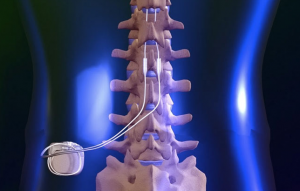12 Aug Spinal Cord Stimulator Implant for Complex Regional Pain Syndrome
FAQs on Spinal Cord Stimulator Implant for CRPS and RSD
Spinal cord stimulation is a groundbreaking treatment to manage complex regional pain syndrome (CRPS). With a permanent spinal cord stimulator implant, patients can have at least 70% reduction in pain caused by this nervous system disorder.
What is complex regional pain syndrome (CRPS)?
Complex regional pain syndrome refers to chronic pain in hands and legs following an injury, stroke, or surgery. The painful disorder is traced to the malfunction of the peripheral and central nervous systems. It is also known as reflex sympathetic dystrophy.
What are the symptoms of complex regional pain syndrome?
 Chronic pain in legs and hands
Chronic pain in legs and hands- Persistent burning or throbbing pain
- Swelling accompanies pain
- Muscle spasm, weakness
- Skin color, texture changes
- Joint stiffness, swelling, damage
- Worsening pain with movement of hand or leg or emotional stress
What causes of complex regional pain syndrome?
- Damage to nerve during an illness or injury
- Nerve damage due to trauma, amputation, or surgery
- Inflammation of nerves feeding extremities
- Dysfunctional nervous systems failing to have inappropriate inflammatory responses
- Smoking leading to vasoconstriction
How common is complex regional pain syndrome?
One in every 20,000 people experiences complex regional pain syndrome. Females are at four-fold higher risk of having this disorder than their male counterparts. CRPS is usually visible in people above 45 years. Most patients affected by this disorder feel pain in arms and hands.
Why should I go for spinal cord stimulator implant for CRPS?
Spinal cord stimulation significantly reduces pain and disability associated with complex regional pain syndrome. It also improves disability and functional status caused by the illness. SCS is an option for those unresponsive to other treatments or do not want to be addicted to painkillers.
How does spinal cord stimulation manage CRPS?
Spinal cord stimulator implanted in a patient’s body sends mild electrical signals to the epidural area. These impulses create a magnetic sphere around the dorsal joints through with nerve fibers carrying pain sensations pass. Electrical pulses affect these nerve fibers causing disruptions in the pain sensation transmission. This leads to pain relief from complex regional pain syndrome.
How effective is spinal cord stimulation for complex regional pain syndrome?
- A 2008 randomized clinical trial discovered 95% patients suffering from complex regional pain syndrome are satisfied with the level of pain relief.
- In 2013, Neuromodulation journal published a research report that strongly suggested using spinal cord stimulation “earlier than a last-resort therapy for CRPS” considering safety, efficacy, and low cost of treatment.
- According to a 2013 study, SCS therapy is “an effective long-term treatment option” for complex regional pain syndrome. Researchers found about 63% patients have satisfactory improvements while the average relief a week after the implant was above 50%.
What is a spinal cord stimulator trial?
An external spinal cord is used during the trial test for patients with complex regional pain syndrome. Electrode leads placed in the epidural place using local anesthesia are connected to the device. These leads deliver electrical pulses generated by the SCS device to the spinal column to disrupt pain signals.
If the trial test succeeds in ensuring 50% complex regional pain syndrome relief over a period of 7 days, the patient is recommended for permanent spinal cord stimulator implant.
How is the permanent spinal cord stimulator implanted in the body?
General anesthesia is administered to the patient. An incision is made to place electrode leads in the epidural place. The device is implanted just above the buttock through another surgical incision and connected to the leads using a wire underneath body tissues. A test run of the spinal cord stimulator follows and incisions are closed.
How is a spinal cord stimulator powered?
A spinal cord stimulator is powered by a rechargeable battery that needs to be replaced in 5 to 10 years depending on the usage. Patients too have the option to go for devices with external batteries.
Who is a candidate for spinal cord stimulator implant?
People with complex regional pain syndrome are considered for spinal cord stimulator implant if they persistent pain unresponsive to medical and alternative therapies. Such candidates must not have spinal problems, neurological disorders, and other conditions that may be adversely impacted with the SCS therapy.
Will the SCS implant hurt?
No, at best there will be mild discomfort and soreness for one or two days. General anesthesia is used to ensure that patients tolerate it easily.
Do I need to stay in the hospital?
Except in rare cases, patients are discharged within hours of the spinal cord implant surgery. It is an outpatient procedure.
What should I avoid after the implant procedure?
- Avoid deep bath
- Avoid sunlight and dust for a week

- Avoid going to work for a week
- Avoid swimming, running, or other rigorous activities for 6 weeks
- Avoid driving for 4 weeks
- Avoid twisting, climbing stairs, and bending for 6 weeks
Are there things I can’t do after SCS implant?
Patients undergoing spinal cord stimulator implant for complex regional pain syndrome cannot HAVE MRI and therapeutic procedures involving ultrasound or microwave diathermy.
When do I need to replace the SCS device?
There is no need to replace a spinal cord stimulator implanted to manage complex regional pain syndrome. It is a life-long procedure. All that you need to replace batteries after a few years.
How often is the battery changed?
Spinal cord stimulator batteries last between 5 to 10 years.
What are side effects of spinal cord stimulator implant?
There is no side effect of spinal cord stimulator impacting the spine. However, the implant procedure may result in avoidable complications, such as bleeding, infection, never injury, damage to the spinal area.
Resources
Poree L, Krames E, Pope J, et al. Spinal cord stimulation as treatment for complex regional pain syndrome should be considered earlier than last resort therapy. Neuromodulation 2013; 16: 125–141.
Kemler MA, de Vet HC, Barendse GA, et al. Effect of spinal cord stimulation for chronic complex regional pain syndrome Type I: five-year final follow-up of patients in a randomized controlled trial. Journal of Neurosurgery. 2008; 108(2), 292-298.
Geurts J, Smits H, Kemler M, et al. Spinal cord stimulation for complex regional pain syndrome type i: a prospective cohort study with long-term follow-up. Neuromodulation: Technology at the Neural Interface. 2013; 16: 523–529.
Sandroni P, Benrud-Arson LM, McClelland RL, et al. Complex regional pain syndrome type I: incidence and prevalence in Olmsted county, a population-based study. Pain. 2003; 103(1-2):199-207.


